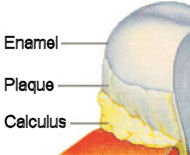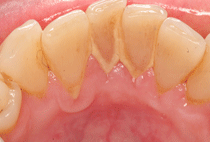
What is Dental Calculus?
Dental Calculus (also known as dental tartar) is a yellowish or brown layer of mineral deposits on the teeth surface created by hardened dental plaque. Tartar control is important for your oral health because, besides the cosmetic problem, it promotes further accumulation of dental plaque, and causes inflammation of gums, gum recession and gum disease.
How dental calculus is formed?
The anaerobic bacteria of dental plaque produce acids as a by-product of their metabolism. These create an acidic environment in the mouth causing the loss of calcium from the tooth enamel (demineralization). Calcium, phosphorus and other minerals from saliva are absorbed into dental plaque and harden its structure. This hardened structure is dental calculus. Its main ingredient is calcium phosphate, a hard insoluble material that adheres to the tooth enamel.
Dental calculus makes rough the surface of the teeth crown and roots, allowing more bacteria and minerals to attach much more easily on the existing plaque. The roughened surface of dental calculus, in combination with the acids produced by plaque bacteria, provide an ideal medium for further accumulation and growth of dental plaque. These repeating cycles of acid production, calcium loss and calcium phosphate deposits result to the build-up of new calculus layers on teeth.
Forms of dental calculus
- Supra-gingival calculus - Calculus above the gum margin is the most common and less harmful type as it is visible and can be easily detected.
- Sub-gingival calculus - Calculus formation below the gums is more dangerous as it forms pockets between teeth and gums, harboring plaque under the gum margin and preventing it from being brushed off.
Problems caused by dental calculus
- Bacteria attach more easily on the rough dental calculus than on smooth tooth surface.
- Food particles and bacteria get trapped underneath calculus beneath the gum line.
- Removing dental plaque with brushing and flossing becomes more difficult.
- Dental calculus irritates the gum tissues and causes gum recession.
- The risk of developing tooth decay and gum disease is increased.
- Teeth look unattractive due to stains accumulated in the porous tartar material.
How to check for dental calculus?
 Contrary to dental plaque that is an almost invisible thin layer, supra-gingival dental tartar deposits are easier to detect.
Look for yellowish and rough areas along the gumline and between teeth.
In most cases, tartar starts to accumulate on the lingual (inside) surface of the bottom front teeth (incisors) and on the outside of the upper, anterior molars.
If when checking using your tongue you feel the inside surface of teeth not as smooth as it used to be, you probably have a problem of calculus formation.
But be aware that the most harmful sub-gingival (below the gums) dental calculus is very hard to detect without a visit to the dentist.
Contrary to dental plaque that is an almost invisible thin layer, supra-gingival dental tartar deposits are easier to detect.
Look for yellowish and rough areas along the gumline and between teeth.
In most cases, tartar starts to accumulate on the lingual (inside) surface of the bottom front teeth (incisors) and on the outside of the upper, anterior molars.
If when checking using your tongue you feel the inside surface of teeth not as smooth as it used to be, you probably have a problem of calculus formation.
But be aware that the most harmful sub-gingival (below the gums) dental calculus is very hard to detect without a visit to the dentist.
Patients who have a tendency to form sub-gingival calculus but not supra-gingival calculus are at higher risk of dental health problems. As sub-gingival calculus is hidden and there is absence of visible calculus above the gums, there is no sign to alert them to visit the dentist. Patients are usually unaware of its existence until suddenly some other symptom as bleeding gums reveals it.
How to Prevent Dental Tartar Buildup?
- Proper brushing and flossing are necessary to reduce plaque and tartar buildup.
- Regular dental cleaning visits to the dentist should also be scheduled.
- Preventive debridement or dental scaling once a year is recommended if you teeth tend to accumulate tartar.
- Use Tartar Control toothpastes
Tartar Control Toothpastes
Tartar control toothpastes are a special type of toothpastes that can help in reducing new tartar build-up but they can't remove the already formed tartar. They work by reducing the concentration of calcium phosphates in the mouth and its absorption from dental plaque, preventing the formation of dental calculus.
A tartar control toothpaste, in some cases, may cause sensitivity to hot and/or cold in some teeth or irritation to the soft tissues of the mouth. Those who are prone to canker sores formation should avoid toothpastes with high levels of sodium-based compounds, like the sodium pyrophosphate contained in tartar control toothpastes.
How to Remove Dental Calculus?
Dental calculus is too hard and strongly bonded on the teeth surface. It can not be removed by normal toothbrushing or by flossing (as we remove dental plaque).
Only professional teeth cleaning by a dentist or dental hygienist can remove it. Dentists use special sharp instruments (dental scalers and currettes) to remove tartar from above and below gumline. Except of manual instruments, dentists also use devices that combine ultra-sonic vibration and irrigation to break up the bacterial plaque and calculus (ultrasonic dental cleaning).
The procedure of removing dental calculus is usually referred as Full Mouth Debridement. However, if there is already a periodontitis problem or the patient has a history of calculus build-up, the dentist will recommend a Deep Cleaning known as Scaling and Root Planing treatment.

